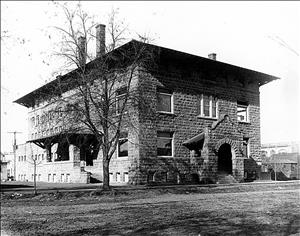On September 1, 1908, the Yakima YMCA opens on S 4th Street near Yakima Avenue in North Yakima. The completion of the facility brings to fruition two years of steady fundraising efforts on behalf of the board of directors, and gives Yakima men and boys a place to meet and socialize.
Alternative to Saloons
A group of community leaders had formed a steering committee to guide the planning process and raise funds for the facility in 1906. W. B. Dudley was elected president of the board. Organizers anticipated that the new facility would be especially useful to construction workers building the irrigation canals that were part of the National Bureau of Reclamation's Yakima Project. Construction on the Yakima Project began in 1906. YMCA organizers were particularly interested in offering these young men an alternative to socializing in North Yakima's saloons. N.F. Turner, a secretary for the Seattle YMCA, was hired to raise funds for Yakima's facility.
The first YMCA (Young Men's Christian Association) was founded in London in 1848. The first American YMCA was organized in Boston in 1851.
YMCA historian Thomas Winter describes the role of the YMCA within communities during this period:
"While the YMCA set out to reform and uplift workingmen, the association also served as an outlet for middle-class men to unite on the basis of a shared manhood and to restore their sense of manliness and cultural authority ... . By the late 19th Century the YMCA had emerged as a major institutional outlet through which middle-class men articulated new definitions of manliness" (p. 4).
These new definitions of manliness included the attainment of physical prowess through physical exercise, a shared moral mission to promote Christianity, and (sometimes) social activism.
Out On A Limb
The Yakima YMCA board of directors moved forward with construction plans even though they still lacked $10,000 to cover the cost of building the facility.
On February 13, 1907, The Yakima Herald announced that the Seattle firm of Gibson and Smith had been awarded the construction contract for the facility. Their bid was $36,794. The Herald described the building plans and the financial risk the board was undertaking by starting construction without sufficient funds:
"The main part of the structure is to be constructed of local sandstone above the water table and of basalt rock below the water table ... the entire amount of money necessary is not subscribed yet, but many have suggested that the matter was not definite enough to warrant their subscribing, and it is hoped and confidently expected that these will show their practical approval of the action of the board by seeing to it that the building is paid for" ("Y.M.C.A. Board ...")
Ground for the YMCA facility was broken with an accompanying ceremony on March 4, 1907. The Yakima Herald explained, "It will mean much in its outcome, not only for the city, but the entire valley and county, the first building of its kinds devoted solely to the purpose of helpfulness and development to young men and boys. Many months have been spent in preparation for this simple event, and in honor of the occasion the whistles of the Cascade mill will put in extra time on that day, blowing from noon to 12:05 in order to remind everybody that there is 'something doing' in town" ("Start Work...").
Get Set, Go
On October 11, 1907, fundraising was finally complete. By May 13, 1908, construction was in the final stages and The Yakima Herald reported that "waterproofing of the swimming pool had been commenced" ("Work For The Boys").
Harry A. Cook of Springfield, Massachusetts, accepted the position of Physical Director. Cook was the Yakima board's top pick. He had previously worked at the Seattle YMCA, then at the Everett YMCA, before moving to Springfield to attend the YMCA's training school. He spent the summers of 1906 and 1907 teaching gymnastics at the University of Washington's summer school.
After the facility opened it was used for worship services and continuing education as well as athletic endeavors. Soon after opening, a residence center, the hallmark of YMCA facilities across the country, was added.
In 1935 the swimming pool was closed and handball courts were built to replace the former gymnasium. In 1958 operations were moved to a new facility at Naches and Yakima avenues.

